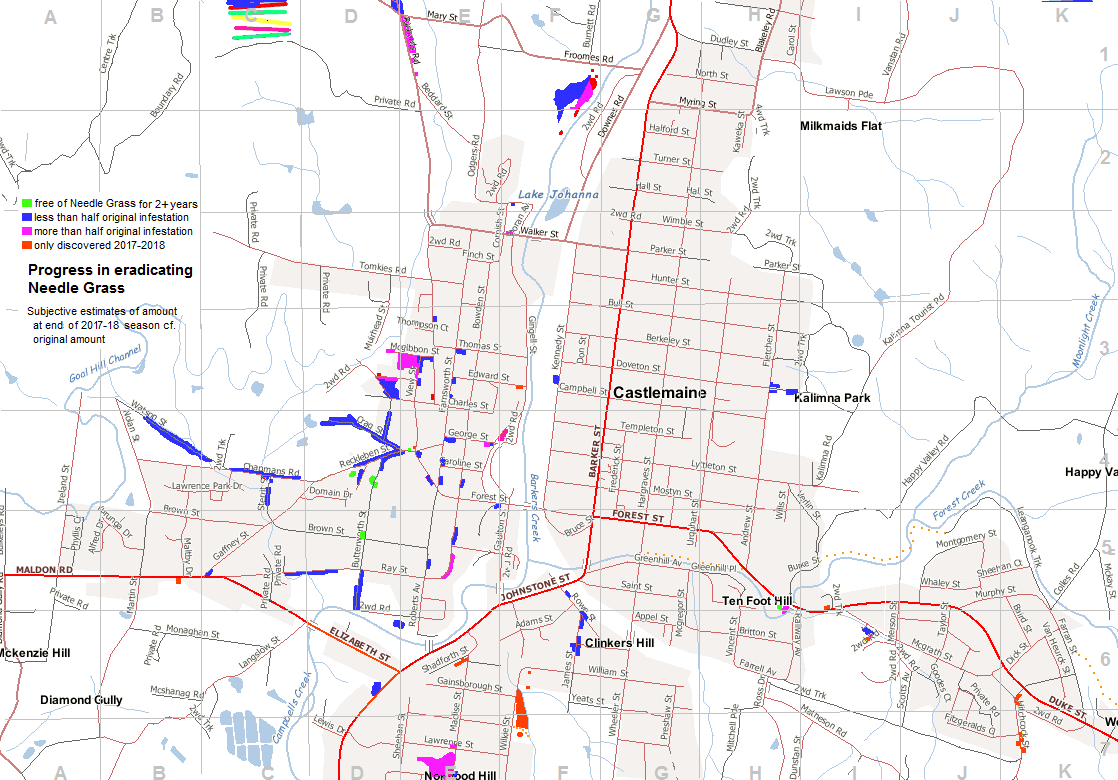FOBIF has completed a preliminary report on its project to control Needlegrasses in Castlemaine. These weeds—related to Serrated Tussock— threaten to cause serious damage to pastures and native environments. They were probably introduced into Victoria from the 1930s, and have the potential to dramatically reduce land value because infestations reduce stock carrying capacity on farmland.
FOBIF gained a small grant from the Mount Alexander Shire to attack the needlegrass problem in 2017. Over the last twelve months project has involved a FOBIF coordinator, 19 volunteers who dug up and removed the weed, one paid weed remover, numerous other residents, council and DELWP staff, as well as landcare groups and Connecting Country.
Progress of the project is shown on the map. The volunteer commitment to further monitoring and removal will continue.

Please note that this is a revised version of the map that was posted on February 2.
The project has been a learning experience. A promising experiment has been made with control via woodchip mulching, and much has been learned about the identification and life cycle of the weeds, and how they spread. It seems very clear that Needlegrass can be spread when infested areas are mown or slashed. Seeds attach to the mower, and unless this is cleaned it spreads the seeds when it moves on to its next job. It’s important therefore that infested areas are clearly identified, and not mown till the weeds and/ or their seeds are removed. Council workers have been increasingly helpful in this respect, but it seems that a more systematic approach to managing roadsides is needed. Not only do council staff need to be well informed about roadside weeds and control methods, but private citizens—residents and contract mowers—need to be better informed about ways to avoid spreading pests.
Roadsides are a long term and ongoing challenge: FOBIF has had occasion before to draw attention to the spread of weeds via dirty machinery, and we notice recent outbreaks of St John’s Wort along roadsides which may have come in this way. We hope that projects like the Needlegrass one will improve cooperation between managers and environmentalists, with better results in the future.
In the meantime, our thanks go to our modest coordinator and the other volunteers for the enormous amount of work they have put into this project.




 Click on image for info/order page
Click on image for info/order page Click on image for info/order page
Click on image for info/order page Click on image for info/order page
Click on image for info/order page






















Fantastic work by all.
Noxious weeds seems to be a neglected area or deemed too hard by government in recent years. This leaves property owners who are in a war with weeds (which compete with their crops and livelihood) financially stressed as they try to manage their properties alone whilst surrounding neighbors and public land weeds flourish and re-invade them. Not to mention the impact on our biodiverse and amazing roadsides.
Mount Alexander Shire undertook a review of roadside management in 2013 including slashing (there is a report) and they developed standard operating procedures etc for the road crew. I am doubtful as to whether this is being put in place ……might be good to follow it up. Kyle Stafford, the environmental officer put a huge effort into making it happen but without all of council support, especially senior management then it falls over (despite these standards also saving council money as the review also indicated that better unsealed road management will last longer, thereby saving money) .